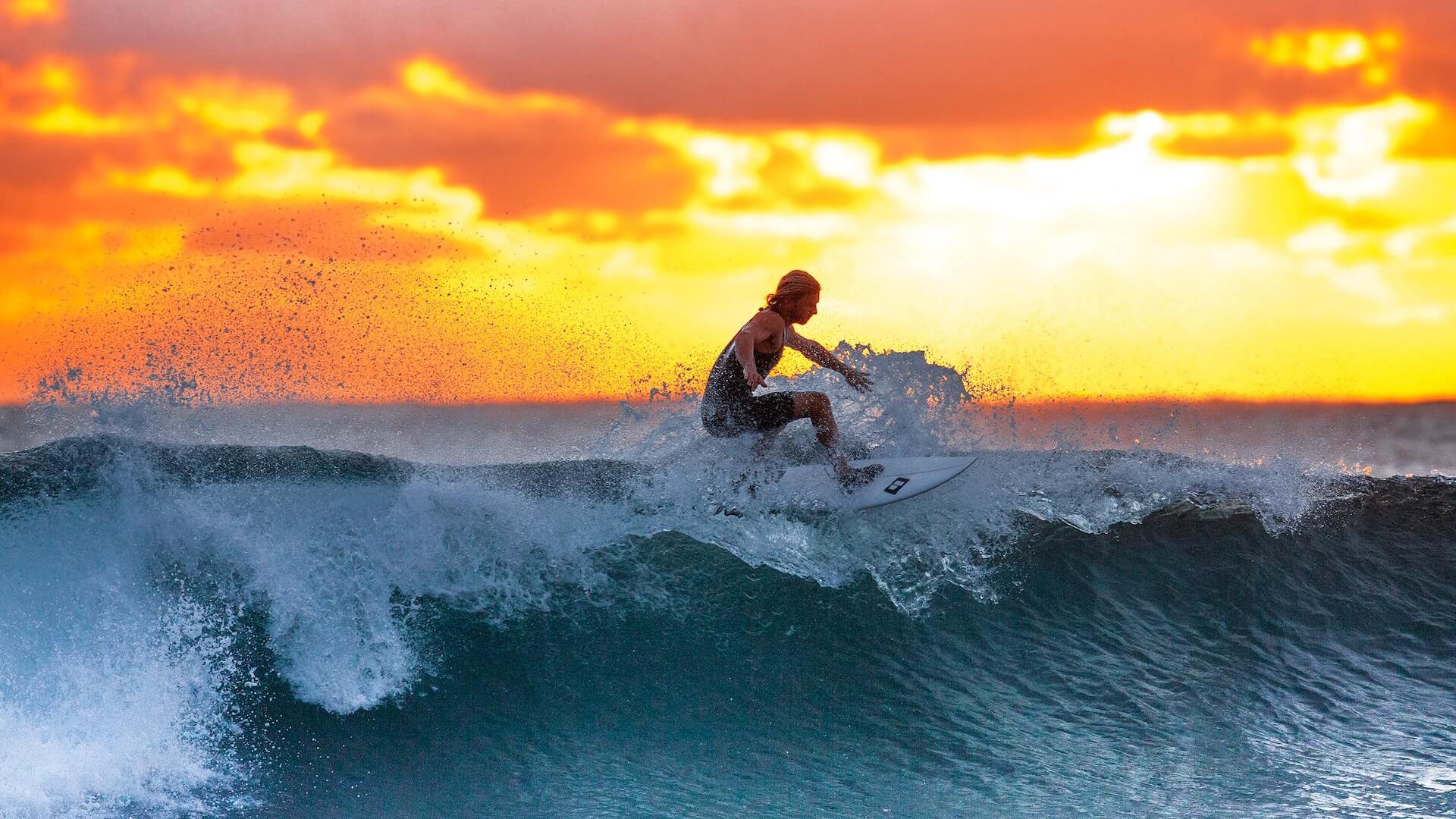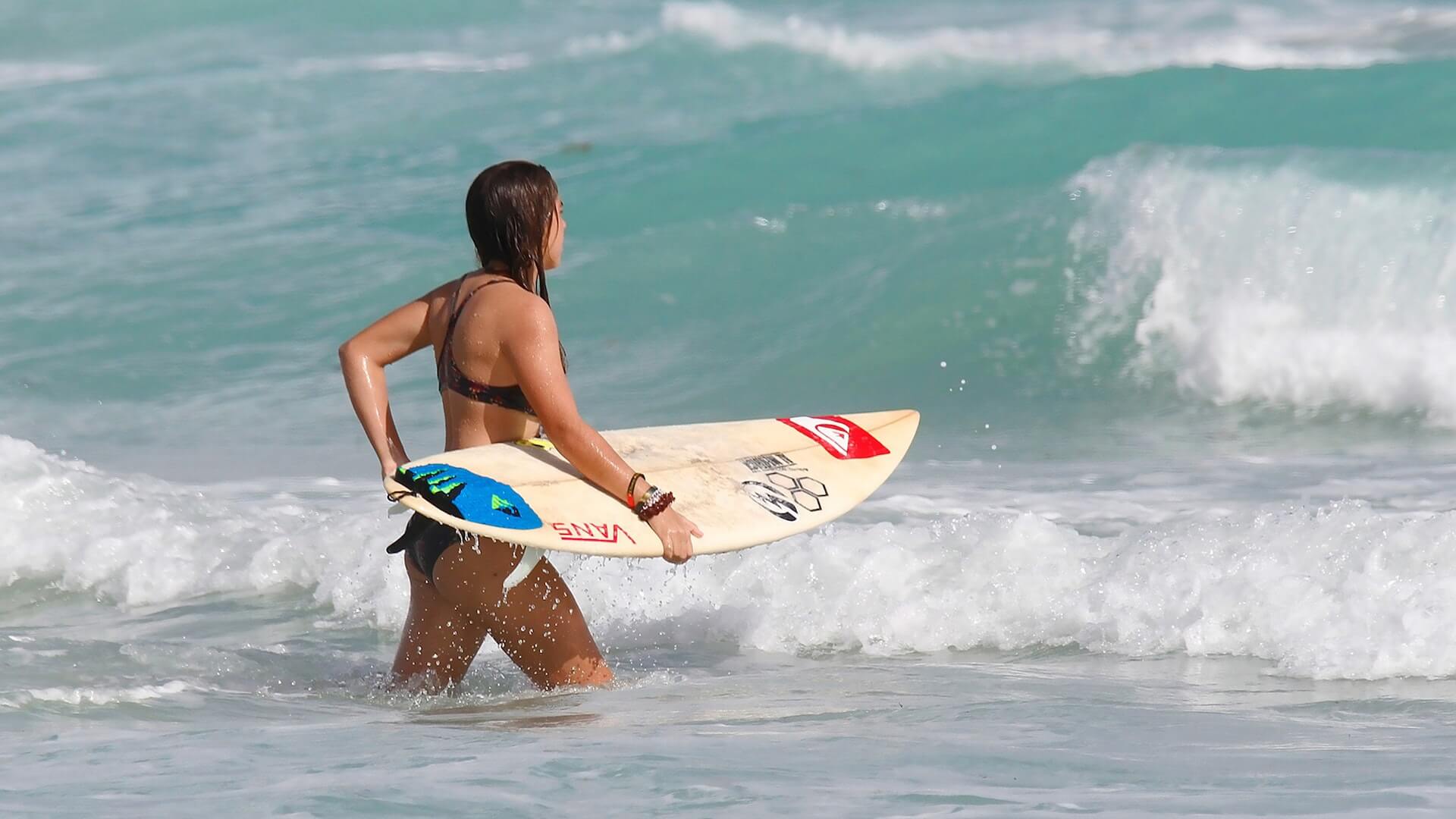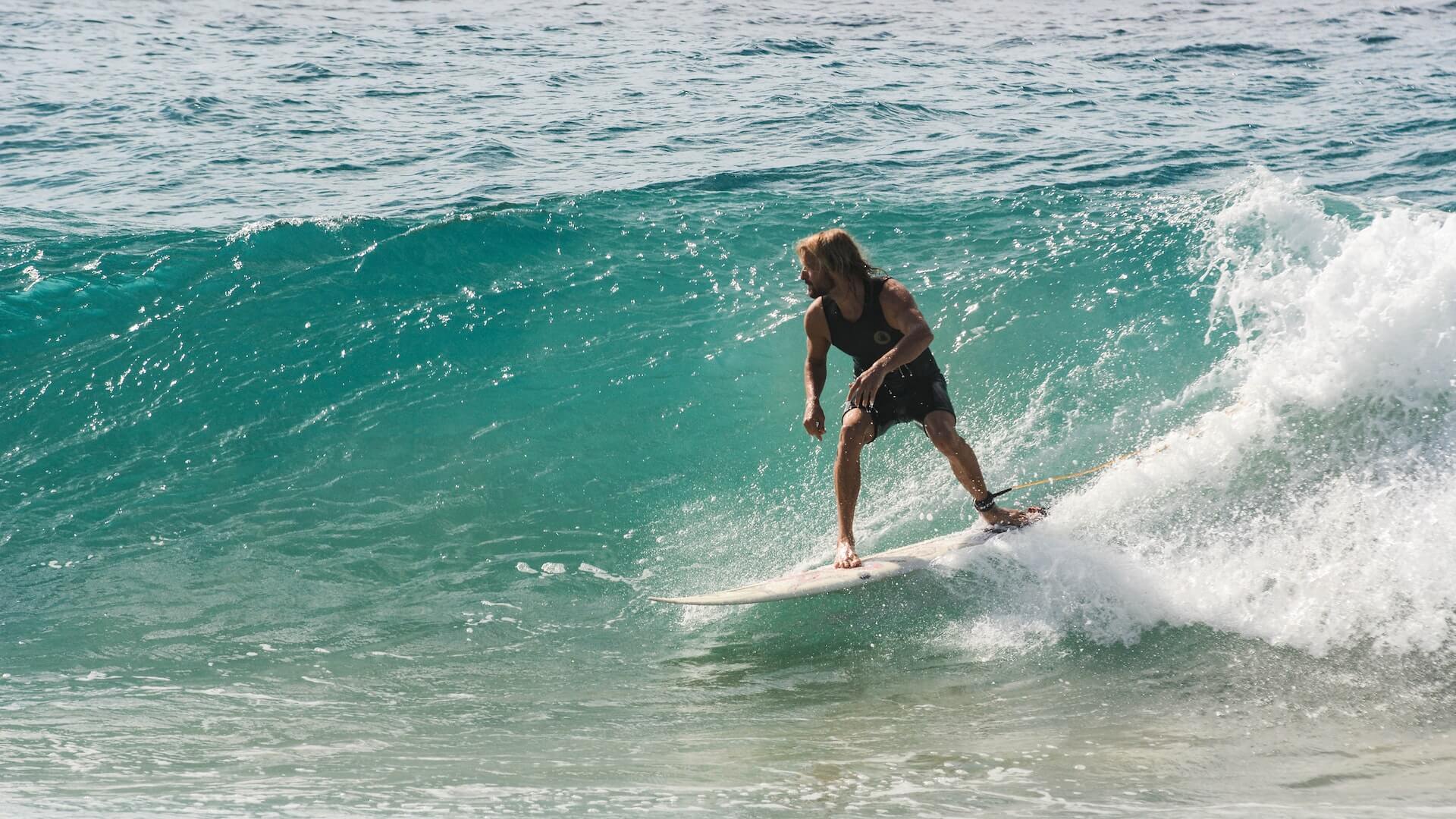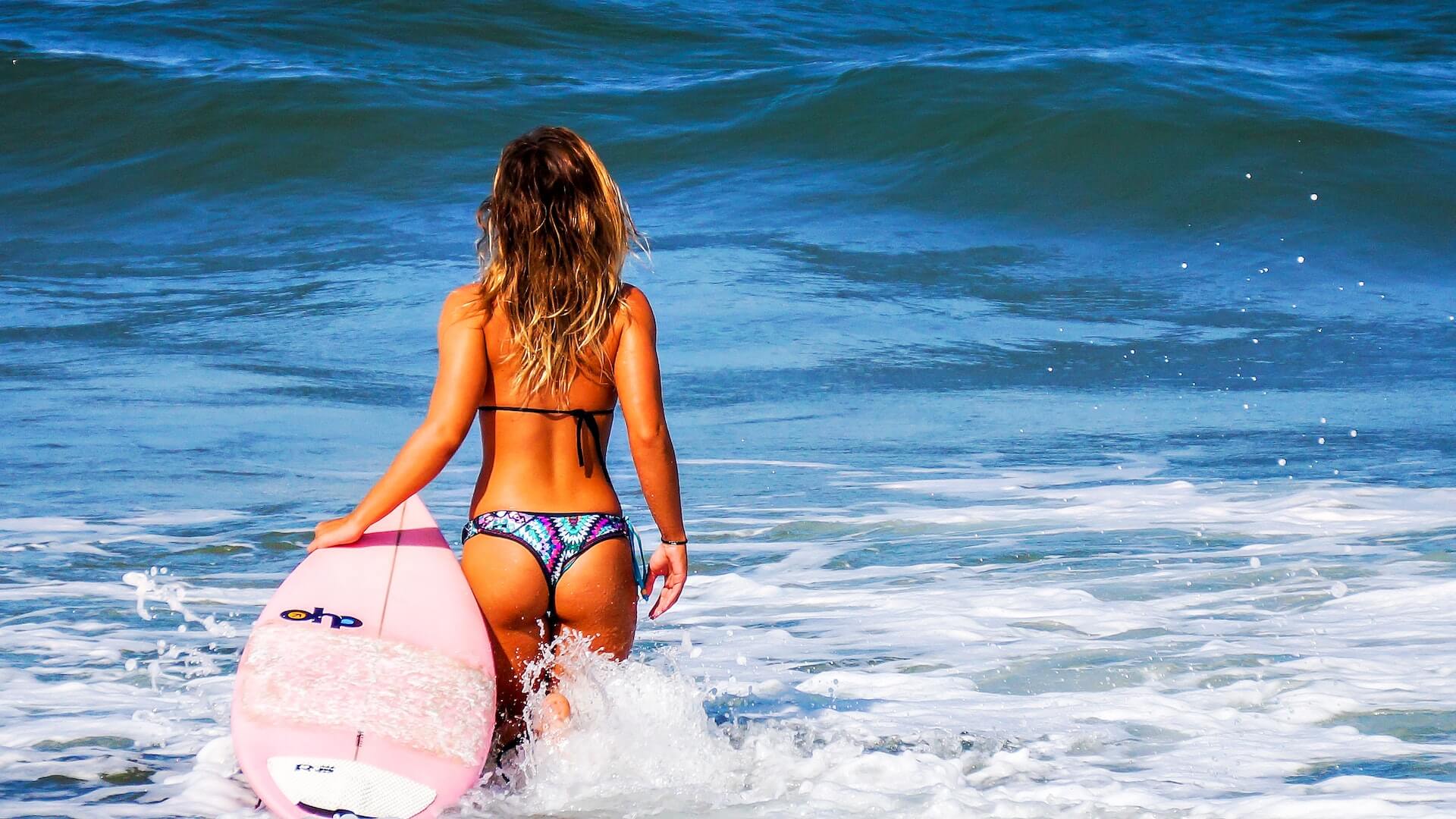Surfing is not just a sport; it’s a way of life. It’s an activity that has been enjoyed by people all over the world for centuries. From the beaches of Hawaii to the coasts of Australia, surfing has become a popular pastime that provides both physical and mental benefits. Not only does surfing provide an adrenaline rush like no other, but it also offers a full-body workout, improves cardiovascular health, and reduces stress levels. But it’s not just about the physical benefits. Surfing is also an opportunity to connect with nature and feel the power of the ocean. In this blog post, we will explore the thrills and benefits of surfing, why it has become a popular sport, and how you can get started today. So, grab your board, wax it up, and let’s hit the waves!
Introduction: The allure of surfing
There’s something magical about the ocean – the vastness of its depths, the crashing of the waves, and the endless horizon that seems to stretch on forever. It’s a world of mystery and wonder, where nature’s power is on full display. And for those who seek adventure and a connection with the elements, there’s no better way to embrace the ocean’s energy than through the exhilarating sport of surfing.

Surfing, at its core, is the art of riding waves. It’s a dance between man and nature, where every movement is in sync with the rhythm of the ocean. But there’s more to surfing than just catching a wave and riding it to shore. It’s a lifestyle, a culture, and a way of life for those who are captivated by its spell.
For many, the allure of surfing lies in the sheer thrill of gliding across the water, feeling the power of the wave propelling them forward. There’s an indescribable rush that comes with being in harmony with the ocean, with the wind in your hair and the saltwater on your skin. It’s a rush that can’t be replicated anywhere else.
But beyond the adrenaline rush, surfing offers a myriad of benefits that go far beyond the surface. It’s a sport that demands physical strength, balance, and coordination. Paddling out to the lineup, navigating the waves, and popping up on the board require a level of fitness and agility that can only be achieved through practice and dedication.
Surfing also provides a unique opportunity for mental and emotional well-being. The act of riding waves requires focus, concentration, and a deep connection with the present moment. In a world filled with distractions and constant stimulation, surfing offers a much-needed escape, a chance to disconnect from the noise and reconnect with oneself.
Moreover, the ocean has a way of instilling a sense of humility and respect in surfers. It teaches them to be in tune with nature, to understand its power and unpredictability. It’s a constant reminder that we are mere specks in the grand scheme of things, and that we must tread lightly and with reverence.
The History of Surfing: From ancient roots to modern sport
Surfing, considered a thrilling and exhilarating water sport, has a rich and fascinating history that spans centuries. Its origins can be traced back to ancient civilizations, where riding waves was not only a means of transportation but also a religious and cultural practice.
The early roots of surfing can be found in Polynesia, specifically in Hawaii, where it was known as “he’e nalu,” meaning wave-sliding. In these ancient times, surfing held deep spiritual significance and was often reserved for the ruling class or individuals of high social status. It was seen as a way to connect with the powerful forces of nature and commune with the gods.
Surfing techniques and equipment evolved over time, with ancient Hawaiians crafting wooden boards from local trees. These boards were meticulously carved and shaped, reflecting the craftsmanship and skill of the surfers who used them. Surfing became an integral part of the Hawaiian way of life, with communities fostering a deep respect and reverence for the ocean.
However, the arrival of European explorers in the 18th century brought significant changes to the practice of surfing. Missionaries and colonizers viewed it as a sinful and pagan activity, attempting to suppress and even ban the sport. As a result, surfing experienced a decline in popularity and was almost lost entirely.
It wasn’t until the early 20th century that surfing began to regain its momentum, thanks to the efforts of a few dedicated individuals. Duke Kahanamoku, an Olympic swimmer from Hawaii, played a pivotal role in reintroducing surfing to the world. His demonstrations and exhibitions in places like California and Australia sparked a renewed interest in the sport.
As the decades passed, surfing continued to evolve, embracing new technologies and innovations. The introduction of lightweight materials such as fiberglass and foam revolutionized board design, making them more maneuverable and buoyant. Surfing became more accessible to a wider audience, no longer confined to coastal communities or tropical paradises.
Today, surfing has become a global phenomenon, attracting enthusiasts from all walks of life. It is not only a sport but also a lifestyle, with countless surf spots and communities around the world. Surfers chase the perfect wave, constantly seeking that unique blend of adrenaline, harmony, and connection with nature.
The Physical Benefits of Surfing: A full-body workout
From paddling out to catching waves and maintaining balance on the board, every aspect of surfing engages and challenges various muscle groups, resulting in a comprehensive physical workout.

First and foremost, paddling through the water requires significant upper body strength, particularly in the shoulders, arms, and back. The repetitive motion of paddling helps to build endurance, improve muscular strength, and enhance overall cardiovascular fitness. It’s no surprise that regular surfers often develop strong and well-defined upper bodies.
Once you catch a wave, the real fun and exertion begin. As you pop up onto the board and ride the wave, your legs and core muscles come into play. Balancing on the board requires a strong core, which includes the abdominal muscles, lower back, and obliques. Engaging these core muscles helps to maintain stability, control, and agility on the constantly shifting surface of the water.
In addition to the core, your leg muscles are constantly working to maintain balance and execute turns while riding the wave. The quadriceps, hamstrings, and calf muscles are all activated as you shift your weight and perform maneuvers on the board. This dynamic lower body engagement not only strengthens and tones your legs but also improves flexibility and coordination.
Surfing is also a fantastic cardiovascular exercise. The combination of intense paddling, quick bursts of energy when catching waves, and continuous movement on the board elevates your heart rate and promotes cardiovascular health. The rhythmic nature of surfing, along with the invigorating ocean environment, makes it an enjoyable way to improve endurance and overall fitness levels.
Moreover, surfing offers the added benefit of being an outdoor activity, allowing you to soak up Vitamin D from the sun and enjoy the natural beauty of the ocean. The calming sound of crashing waves and the refreshing sea breeze create a serene and therapeutic environment, enhancing the overall experience and contributing to mental well-being.
The Mental Benefits of Surfing: Finding peace and mindfulness
One of the most profound mental benefits of surfing is the ability to find peace and mindfulness amidst the chaos of the crashing waves. When you’re out there on your board, floating in the vastness of the ocean, there is a certain sense of calm and serenity that washes over you. The sound of the waves, the rhythm of the tide, and the feeling of being connected to nature all contribute to a meditative state of mind.
Surfing requires focus and concentration. As you paddle out, position yourself on the board, and catch a wave, your mind becomes fully engaged in the present moment. There is no room for worries, stress, or distractions. It’s just you, your board, and the ever-changing ocean. This intense focus on the present creates a sense of mindfulness, where all your worries melt away and you become fully immersed in the experience.
The act of riding a wave also provides a unique form of therapy. The physical exertion combined with the exhilaration of catching a wave releases endorphins, those feel-good hormones that boost your mood and reduce stress. It’s a natural high that leaves you feeling refreshed, invigorated, and more balanced emotionally.
Moreover, the unpredictability of the ocean forces surfers to adapt, be patient, and let go of control. You learn to surrender to the power of the waves and trust in your own ability to navigate through them. This surrender and acceptance of the uncontrollable elements of nature can translate into a greater sense of acceptance and resilience in other areas of life.
The Thrill of Riding Waves: The adrenaline rush that keeps surfers hooked
Picture yourself standing on a pristine beach, gazing out at the vast expanse of sparkling ocean before you. The waves roll in, beckoning you to paddle out and take on their power. As you paddle into position, your heart starts to race with anticipation.

Once you catch that perfect wave, everything else fades away. You feel an adrenaline surge as you drop down the face of the wave, the water rushing past your board. The speed and power of the wave propel you forward, and for those few fleeting moments, you are in complete harmony with the ocean.
The thrill of surfing lies in the unique combination of skill, athleticism, and connection with nature. It’s a dance between you, your board, and the ever-changing waves. The exhilaration of successfully riding a wave, maneuvering effortlessly through its twists and turns, is unparalleled.
But it’s not just the adrenaline rush that keeps surfers coming back for more. Surfing offers a myriad of benefits beyond the thrill. It provides an escape from the stresses of everyday life, allowing you to immerse yourself in the present moment. The rhythmic motion of paddling and the sound of the waves create a soothing and meditative experience, giving you a sense of peace and tranquility.
Surfing also offers a great workout. Paddling strengthens your upper body and core muscles, while riding waves challenges your balance, coordination, and agility. It’s a full-body workout that leaves you feeling invigorated and energized.
Furthermore, surfing fosters a deep connection with nature. Spending time in the ocean, feeling the power of the waves beneath you, and witnessing the beauty of the coastal landscape is both humbling and awe-inspiring. It instills a sense of respect and appreciation for the natural world, reminding us of our place within it.
Surfing as a Social Activity: Building a community of like-minded individuals
Surfing isn’t just a sport; it’s a lifestyle. One of the most rewarding aspects of surfing is the opportunity to build a community of like-minded individuals who share your passion for riding the waves. Whether you’re a beginner or a seasoned pro, the surfing community is known for its inclusivity and camaraderie.
When you paddle out into the lineup, you become part of a unique social fabric. Surfers from all walks of life come together, united by their love for the ocean and the thrill of catching waves. It’s common to strike up conversations with fellow surfers while waiting for the next set, sharing stories, tips, and even local surf spot secrets.
Surfing provides a natural platform for fostering connections and creating lasting friendships. You’ll often find surfers organizing group surf sessions, where everyone supports and encourages each other to improve their skills. This sense of community extends beyond the waves, as surfers often gather for beach clean-ups, fundraisers, and other events that promote environmental conservation and ocean awareness.
Thanks to the widespread popularity of social media, the surfing community has expanded its reach globally. Online forums, surf-specific apps, and social networking platforms allow surfers to connect with like-minded individuals around the world. You can share your surf adventures, exchange tips on wave conditions, and even plan surf trips together.
Being part of a surfing community offers numerous benefits. Not only do you gain access to a wealth of knowledge and experience, but you also have a support system that pushes you to overcome challenges and reach new heights in your surfing journey. The friendships formed within the surfing community are often built on shared experiences, creating bonds that can last a lifetime.
Surfing Destinations: Exploring the world’s best surf spots
One of the most iconic surf spots in the world is Pipeline, located on the North Shore of Oahu, Hawaii. Known for its powerful and hollow waves, Pipeline attracts pro surfers from around the globe who showcase their skills on these legendary breaks. The adrenaline rush of riding these waves is truly unmatched.
For those seeking a tropical paradise, the Mentawai Islands in Indonesia are a surfer’s dream come true. With crystal-clear waters, palm-fringed beaches, and consistently perfect waves, it’s no wonder this archipelago is considered a Mecca for surfers. From long, peeling point breaks to fast and barreling reef breaks, the Mentawai Islands offer a variety of surf breaks for all levels of experience.
If you’re looking for a European surf adventure, look no further than Portugal’s Peniche. This coastal town is home to the famous Supertubos, a world-class beach break that produces powerful and hollow waves. With its vibrant surf culture and stunning coastline, Peniche has become a hotspot for surfers seeking an unforgettable experience.
Australia is another surfing paradise, with a plethora of world-class surf spots along its vast coastline. One standout location is Bells Beach in Victoria, renowned for its powerful and consistent waves. This iconic surf spot has hosted the Rip Curl Pro, attracting top surfers from around the world to compete in its challenging breaks.
For those seeking a unique and remote surfing adventure, consider exploring the waves of Jeffreys Bay in South Africa. Known as “J-Bay” to the surfing community, this world-renowned right-hand point break offers long and fast barrels that will leave you in awe. Surrounded by natural beauty and wildlife, J-Bay provides an unforgettable surfing experience like no other.
Surfing Gear: Essential equipment for beginners and advanced surfers
When it comes to surfing, having the right gear is essential for both beginners and advanced surfers alike. The right equipment not only enhances your performance but also ensures your safety and comfort in the water.

For beginners, a good quality surfboard is crucial. It’s recommended to start with a longboard, as it offers stability and ease of paddling, making it ideal for learning the basics of surfing. Additionally, a leash should always be attached to your surfboard to prevent it from drifting away if you fall off.
Another essential piece of gear is a wetsuit. Depending on the water temperature, you may need a full wetsuit or a spring suit. A wetsuit not only keeps you warm but also provides protection against the elements and potential board rash.
As you progress in your surfing journey, you may consider upgrading your board to a shorter, more maneuverable one. A good option for intermediate to advanced surfers is a fish or a thruster board, which offers greater maneuverability and responsiveness on the waves.
In addition to the surfboard and wetsuit, other essential gear includes surf wax, which helps provide traction on the board, and surfboard fins, which affect the board’s stability and maneuverability.
For safety purposes, it’s important to invest in a good quality surf helmet, especially when surfing in more challenging conditions or crowded lineups. Additionally, wearing earplugs can protect your ears from cold water and prevent potential ear infections.
Lastly, don’t forget about the importance of sunscreen. Surfing exposes your skin to the sun’s harmful rays, so it’s crucial to apply a waterproof sunscreen with a high SPF to protect your skin from sunburn and potential long-term damage.
Safety Tips for Surfers: Staying safe in the water
When it comes to surfing, safety should always be a top priority. While the thrill of riding the waves is exhilarating, it’s important to remember that the ocean can be unpredictable and potentially dangerous. By following some essential safety tips, you can ensure a safer and more enjoyable surfing experience.
First and foremost, it’s crucial to be aware of the conditions and know your own limits. Before heading out into the water, check the surf forecast and assess the wave size, currents, and weather conditions. If you’re a beginner or unfamiliar with the spot, it’s advisable to start with smaller waves and gradually work your way up.
Wearing the right safety gear is another essential aspect of staying safe while surfing. Always wear a properly fitted leash to keep your board attached to you. This not only prevents you from getting separated from your board but also ensures that your board doesn’t become a hazard to other surfers in the water.
Additionally, wearing a well-fitting surfboard leash can prevent accidents caused by loose boards being carried by waves. It’s also wise to invest in a good-quality surfboard that suits your skill level and the conditions you’ll be surfing in.
Staying mindful of other surfers in the water is crucial for maintaining a safe environment. Respect the lineup etiquette, take turns, and communicate with fellow surfers to avoid collisions or conflicts. Pay attention to your surroundings, including other surfers, swimmers, and any potential hazards such as rocks or reefs.
Furthermore, it’s important to be aware of your own physical abilities and limitations. Surfing requires a certain level of fitness and stamina, so it’s essential to stay in good shape and be able to swim confidently.
Lastly, always listen to and follow the instructions of lifeguards or local surf instructors. They have the expertise and knowledge of the area, and their guidance can help prevent accidents or risky situations.
Getting Started: How to begin your surfing journey
Embarking on a surfing journey can be an exhilarating and transformative experience. Whether you’re drawn to the thrill of riding waves or the serene connection with nature, the first step in your surfing journey is crucial. Here are some essential tips to help you get started.

1. Find a Suitable Surfing Spot:
Research and locate a beach that offers ideal conditions for beginners. Look for spots with gentle waves, sandy bottoms, and a gradual slope. Avoid crowded areas to ensure a safer and more enjoyable experience.
2. Invest in Quality Gear:
A good surfboard and wetsuit are essential for a comfortable and effective surfing session. Seek advice from experienced surfers or visit a local surf shop to find the right equipment that suits your skill level and body type.
3. Take a Lesson or Surfing Course:
Enrolling in a surfing lesson or course with a qualified instructor can significantly accelerate your learning curve. They will teach you fundamental techniques, safety guidelines, and provide valuable feedback to improve your skills.
4. Master the Basics:
Before venturing into the water, familiarize yourself with basic surfing techniques such as paddling, popping up, and proper stance. Practice these on land or in shallow water to build muscle memory and gain confidence.
5. Understand Ocean Awareness:
Developing a solid understanding of ocean conditions, tides, currents, and weather patterns is crucial for your safety. Learn how to read waves, identify rip currents, and respect the power of the ocean.
6. Start Small and Progress Gradually:
Don’t be discouraged if you don’t catch big waves right away. Begin on smaller, rolling waves to build your balance, timing, and board control. As you gain experience and confidence, gradually challenge yourself with larger waves.
7. Respect Surfing Etiquette:
Surfing has its own unwritten rules and etiquette. Respect the lineup, wait your turn, and be mindful of other surfers. Learning and adhering to these unwritten rules will help create a positive and harmonious surfing community.
8. Stay Persistent and Have Fun:
Like any new skill, surfing takes time and practice to master. Embrace the learning process, stay persistent, and most importantly, have fun! Enjoy the rush of catching waves, the thrill of progression, and the serenity of being in harmony with the ocean.
Conclusion
Surfing is not just a sport; it’s a way of life that offers unique experiences and countless benefits. From the adrenaline rush of catching a wave to the meditative and therapeutic effects of being in the water, surfing has something to offer everyone. Whether you’re a seasoned surfer or someone looking to try it for the first time, we encourage you to dive into this incredible world and explore the endless possibilities that come with riding the waves. So grab your board, embrace the ocean, and let the adventure begin!



